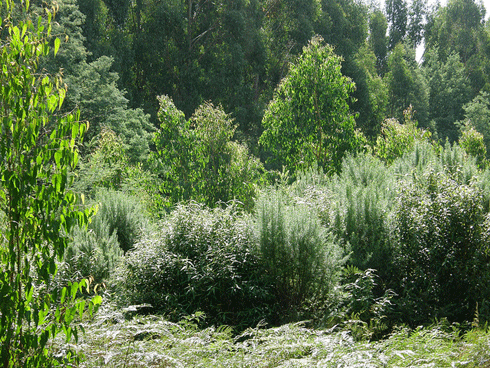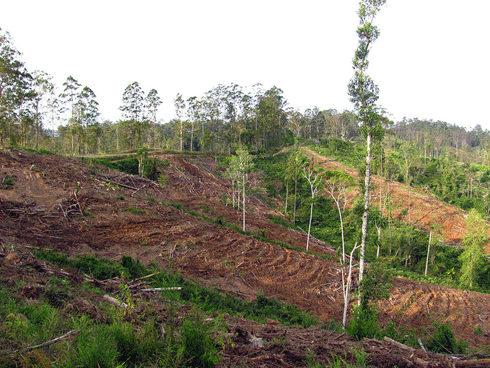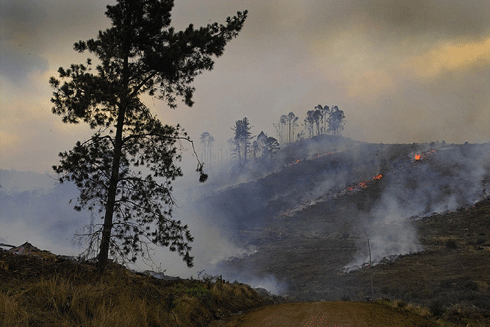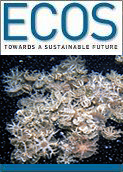
|
Published: 3 September 2012
Offset plantations and the risk of ‘bio-perversities’
Carbon offset plantations are viewed by many as a new ‘gold rush’. But the narrow focus on planting trees to offset carbon emissions has many ecologists worried. How do carbon plantations affect local biodiversity? What about the increased pressure on water resources? Or the potential for introduced species to become weeds in the new area?

|
|
Leading scientists say better planning is needed for carbon plantations to protect biodiversity, ecosystem services and long-term carbon sequestration potential.
Credit:
David Salt
|
When it comes to locking up carbon, one popular strategy frequently put forward is the establishment of tree plantations – large, commercial-scale plantations that offer the promise of locking up carbon while at the same time growing timber, a valued commodity.
For land owners, it’s a financial incentive to increase the carbon storage value of their land by increasing vegetation cover. Many say this is a good thing, as it could help restore degraded land and better protect biodiversity.
But a growing number of scientists are advising caution. They say a narrow focus on carbon storage has the potential to create significant negative environmental outcomes if other values such as biodiversity are not explicitly considered.
Australian researchers have even come up with a name for it – bio-perversity. They define bio-perversity as the negative biodiversity and environmental outcomes arising from a narrow focus on single issues, without consideration of the broader ecological context.
In a recent article published in the journal Conservation Letters, a group of eminent scientists – led by Professor David Lindenmayer from the Australian National University and the ARC Centre of Excellence for Environmental Decisions (CEED) – expressed concern that a poorly planned plantation boom could result in needless land clearing, increase the risk of invasive species and damage natural ecological processes.
Professor Lindenmayer – whose co-authors include the University of Western Australia’s Professor Richard J. Hobbs, CEED’s Professor Hugh Possingham and Climate Commissioner Professor Will Steffen – points out that incentives to sequester carbon through establishing plantations are likely to increase as the impacts of climate change become more pronounced and intense.
‘We argue that harmful outcomes for biodiversity – what we term “bio-perversities” – can arise as unintended consequences from a range of efforts to enhance forest-based carbon sequestration.
‘Perhaps the greatest of the associated potential bio-perversities are those which may arise from ill-conceived or inappropriate large-scale plantation projects.
‘Our purpose in writing this paper was twofold. First, we wanted to put up a red flag on the risks of rushing into plantation development with a narrow focus on carbon. Second, we’re suggesting ways these risks can be avoided.’
The researchers identified three types of bio-perverse outcome arising from carbon sequestration plantations:
-
the clearing of land to establish tree plantations,
-
the risks of plantation trees becoming invasive plants, and
-
the potential for plantations to affect the local ecology, for example, through increasing the demand for water or increasing the risk of fire.
Climate change, they add, will further complicate any negative outcomes. The news, however, is not all bad. Professor Lindenmayer says the team has identified four strategies to mitigate the risk of bio-perversity.
‘These involve ecological risk assessments, full carbon accounting of ecosystems and proposed management activities, an examination of incentives used to stimulate the establishment of tree plantations, and the establishment of compliance and ecological monitoring programs to detect bio-perverse outcomes,’ he says.
‘Each of these strategies would deal with the three areas of bio-perversity to differing degrees.
‘For example, in considering the risk of land clearing to establish tree plantations, full carbon accounting assessment of areas being considered for conversion to plantations will be of particular importance.
‘Such an accounting may demonstrate the carbon sequestration value of maintaining native forest or grassland compared with the establishment of a plantation.
‘Several studies have shown that monocultures of plantation trees may take longer to produce a net carbon gain and ultimately store less carbon in above ground biomass and soil organic carbon than native primary forests, secondary (regenerating) native forests, and multistrata agroforestry plantings.
‘The risk of plantation trees becoming invasive plants is another real possibility of bio-perversity arising from carbon plantations. The most frequently used species in plantations are quick growing trees – pines, gumtrees and wattles for example – that are tolerant to a wide range of environmental conditions. When established outside their original range, some of these plantation tree species can become invasive.
‘Bio-perverse outcomes include impacts such as biotic homogenisation, genetic swamping and altered ecosystem processes. These sometimes irreversible invasions can often become costly to manage and lead to significant biodiversity loss.
‘But the threat of invasives would be reduced with appropriate ecological risk assessment, a careful scrutiny of the types of incentives being employed to encourage plantation establishment and appropriate ecological monitoring, both within and outside plantation estates to provide early warnings of invasives were they to occur,’ suggests Prof. Lindenmayer.
‘The modification of key ecosystem processes is another well-recognised impact leading to biodiversity loss in many parts of the world, and plantation establishment could play a key role in causing it.
‘In particular, plantation establishment is suggested to have large impacts on hydrologic, geomorphologic and fire regimes both within plantations as well as in the surrounding landscapes.
‘Thorough, knowledge-based risk assessments of plantation projects and ecological monitoring will be essential for early detection and minimisation of potential bio-perverse outcomes such as altered hydrologic and geomorphic cycles and altered fire regimes.
‘Some locations will be deemed unsuitable for plantation establishment as a result of these considerations. It is imperative that incentives schemes and reward systems have clear regulations to prevent the establishment of plantations in regions that are unsuitable.
‘If the rush to plant trees and establish plantations for carbon sequestration results in a range of other environmental values being ignored, we expect big problems to follow.
‘A narrow focus on carbon may well exacerbate a range of existing environmental problems, contribute to further biodiversity loss, introduce additional obstacles to recovering or maintaining the ecological integrity of environments, and ultimately fail to mitigate the anthropogenic causes of climate change.
‘And that would be a perverse outcome indeed of a venture that was intended to ameliorate the root cause of climate change.’
This article first appeared in Decision Point, the monthly magazine of the Environmental Decision Group, funded by the ARC Centre of Excellence for Environmental Decisions (CEED) and the National Environmental Research Program (NERP) Environmental Decisions Hub.
More information
Lindenmayer DB, KB Hulvey, RJ Hobbs, M Colyvan, A Felton, HPossingham, W Steffen, K Wilson, K Youngentob & P Gibbons (2012). Avoiding bio-perversity from carbon sequestration solutions. Conservation Letters 5: 28–36.
|
1. Ecological risk assessment |
Such an assessment would include: |
|

A three-year-old stand of mixed plantings in South Australia: some carbon offset businesses, such as the not-for-profit organisation Greenfleet, try to ensure that their tree-planting programs include a range of local species to mimic an area’s pre-disturbance biodiversity. Credit: Greenfleet/flickr. Creative Commons Attribution-NonCommercial-NoDerivs 2.0 Generic licence.
|
2. Full carbon accounting |
This would include quantifying the amount of carbon to be sequestered in plantations relative to the ecosystems they replace – for example, accounting for all emissions associated with plantation establishment (land clearing, burning, tree propagation, transportation, etc.) and plantation management (road construction and timber haulage). |
3. Assessment of incentives |
The aim of such an assessment would be to create incentives that broaden plantation goals beyond carbon sequestration to include a range of ecologically desirable environmental outcomes, including the maintenance of biodiversity – an example is REDD+. |
4. Compliance and ecological monitoring programs |
Such programs should include both local level ‘participatory’ monitoring as well as regional and national level ‘expert-based’ monitoring. Both kinds of monitoring at different scales would be critical for providing feedback to policy-makers and investors to alter incentive schemes and management practices to limit the risks of bio-perversity. |





